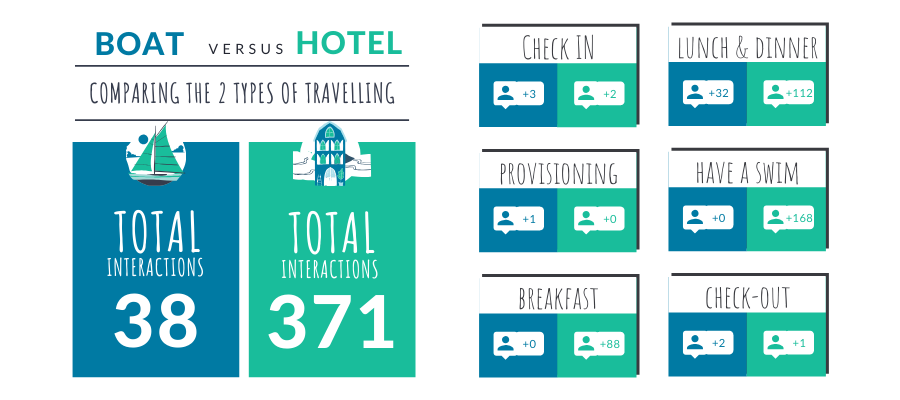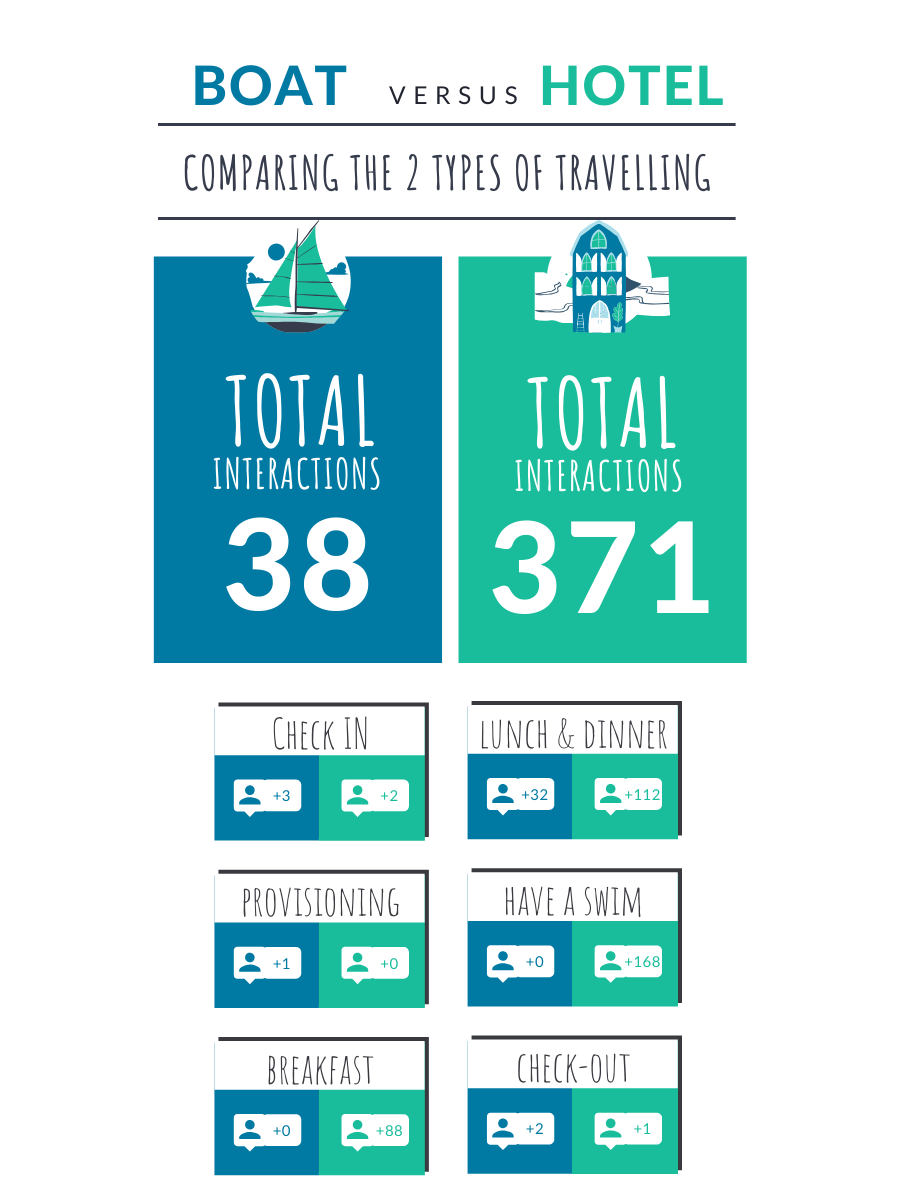COVID-19: A week on a boat is 10 times safer than a week at a hotel
Boat vacations have become the safest way to enjoy the beach and the sun, far away from Covid 19. In Boatjump, we have wanted to go above and beyond, quantifying the approximate number of interactions for the 3 main tourism options: hotels, cruises, and touristic apartments.
Why have we decided to use this variable as a reference? All of the authorities have advised that one of the fundamental keys is social distancing, until a vaccine is created or there is a treatment, both of which will take time.
In every situation, the group should always be the following: friends and groups of friends.
We were surprised when we designed the infographic, which you have seen above, and we realized that there is a huge difference and consequently, a difference in the potential risks of infection.
In the following, you can see and analyze all of the hypotheses that we have kept in mind while writing this study. We hope that you find this useful!
DEFINITION OF THE DIFFERENT TYPES OF TRIPS
- Trip #1: “Boat Charter”: One week on a boat (sailboat, catamaran, or yacht) that is chartered with a captain that takes care of you. Passengers get off the boat on land in specific points to eat or have a drink.
- Trip #2: “Hotel”: One week at a hotel with 100 rooms. The hotel is by the beach with a pool and breakfast included. Meals are eaten outside of the hotel and you go to the beach and the pool.
- Trip #3: “Cruise”: One week on board an all-inclusive cruise ship with 1,000 cabins cruising on the Mediterranean. Passengers get off the boat in each city for tourism.
- Trip#4: “Tourist Apartment”: One week in a tourist apartment in a residential area with a pool close to the ocean. Guests leave specifically to eat or have a drink outside of the apartment and go to the beach or the pool.
IDENTIFY THE NUMBER OF INTERACTIONS
The second step is to identify the number of interactions that one will have during the main things they do during the week of their vacation. We show here the 7 main interactions that we have identified:
- Check in: all 4 of these trip choices require a process of check-in to be able to receive the service:
- Boat: 3 interactions: 1 receptionist of the charter company + 1 captain who will spend the week navigating your boat + 1 person who will accompany the boat during check-in and release the moorings.
- Hotel: 2 interactions: 1 receptionist + 1 bellhop that accompanies you to the room.
- Cruise: 2 interactions: different from the hotel and chartering a boat, on a cruise, all of the passengers will board at the same time during a length of time, usually in groups of 50 people, before setting sail. Further along we will explain that during the week of sailing, one has interactions with almost 100% of the other passengers and the crew members. Therefore, during the check-in we will only count those that are on land, which in this case are the 2 people that organize the group of 50 people to get on board the cruise ship.
- Apartment: 1 interaction: with the landlord of the apartment or the person that is in charge of the check-in.
- Buying Food
- Boat: 1 interaction: the most usual situation is to buy your food online to load it on the boat before boarding. One only interacts with the supermarket delivery person.
- Hotel: 0 interactions.
- Cruise: 0 interactions.
- Apartment: 1 interaction: one orders their food online and this way they only have contact with the supermarket delivery person.
- Breakfast:
- Boat: 0 interactions. One eats breakfast onboard the boat.
- Hotel: 88 interactions: A hotel with 100 rooms has a capacity of 200 people that changes by 30% during the week. There are also 20-25 workers. We can imagine that there will be a 60% occupation rate due to Covid. This would mean a total of 176 people with whom to potentially interact with during the week. Of these 176 people, one will interact with 50% of them during breakfast, and the other 50% at the pool or in common areas.
- Cruise: 450 interactions: during the 7 days, all of the passengers will interact, at one point or another, with almost 100% of the other passengers and the crew members. A cruise ship with 1,000 cabins and an occupation rate of 60% due to Covid, will have 1,200 passengers and 600 crew members, which gives a total of 1,800 passengers on board. These people will be dispersed among 4 different situations (breakfast, lunch, dinner, and the pool). Result: 450 people in each situation.
- Apartment: 0 interactions: the most usual situation is that one eats breakfast in their apartment.
- Lunch and Dinner: (premise: in each lunch and dinner on land we interact with 8 people: 3 waiters/waitresses and the closest table of 5 guests).
- Boat: 32 interactions: if one decides to go on land for 2 lunches and 2 dinners. The rest of the meals can be eaten on board.
- Hotel: 112 interactions: without lunch and dinner included, one has to eat these meals outside of the hotel for all 7 days.
- Cruise: 900 interactions: these are the interactions that one will have with the rest of the people on board, excluding the interactions at breakfast and at the pool.
- Apartment: 32 interactions: if one decides to go out of the apartment for 2 lunches and 2 dinners. The rest of the lunches and dinners can be made in the apartment.
- Swimming in The Pool:
- Boat: 0 interactions: there is no pool, just the ocean.
- Hotel: 88 interactions: these will be with the rest of the people in the hotel, excluding the interactions that one has already had at breakfast.
- Cruise: 450 interactions: these will be with the rest of the people on board, excluding the interactions that one has already had at breakfast, lunch, and dinner.
- Apartment: 70 interactions: it is assumed that if one rents a touristic apartment with a pool, this person will go to the pool at least once a day. The capacity of these pools is usually 50 people, therefore one can imagine interacting with 10 people each day of the week, as this is a large, open space.
- Swimming in The Ocean:
- Boat: 0 interactions: one does not have contact with other individuals, as they are not on the beach, but anchored out at sea.
- Hotel: 80 interactions: the most usual situation that occurs when one reserves a hotel by the beach, is to go to the beach at least half of their vacation days (4 days). On a beach that has normal density of swimmers it would be reasonable to interact with 20 people during the day.
- Cruise: 140 interactions: on a cruise ship the most usual situation is to go on excursions on land each day. One can assume that an excursion is 8 hours and they will interact with 30 different people during the experience.
- Apartment: 80 interactions: the same calculation can be applied here as was applied for guests at a hotel.
- Check-out:
- Boat: 2 interactions: receptionist of the charter company + 1 mooring sea hand.
- Hotel: 1 interaction: receptionist.
- Cruise: 2 interactions: the 2 organizers of the offboarding of the group of 50 people.
- Apartment: 1 interaction: 1 with the landlord of the apartment or the person that is in charge of the check-out.
CLARIFICATIONS
- It is assumed that these 4 types of trips will comply with the necessary sanitary measures and the social distancing measures that are recommended by the authorities; due to the diligent professionalism of the businesses in these 4 sectors.
- These are estimates of reality, in each of these specific cases the real number of interactions could differ.
- We have excluded from this analysis the factor of transportation from the home of the family/group of friends to the place they are going for vacation, as this does not influence in the number of interactions that each person will have in each of the different types of trips that we talk about in this article.
CONCLUSIONS
Boat charter vacations have the lowest number of interactions with other people from the 4 different trip types presented and analyzed here. Furthermore, the number of interactions during a boat vacation could be reduced by 84%, if the passengers don’t get off the boat during the entire week; which is completely possible.
- Virgin Islands Charters ⛵ - December 14, 2022
- Stories Surrounding BVI - August 25, 2022
- Greece is the place for Sailors and Adventure Seekers - August 24, 2022



